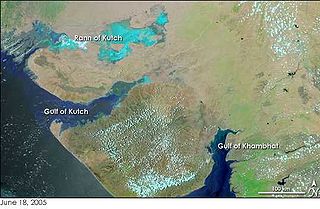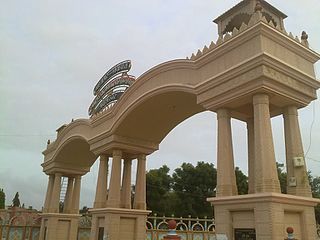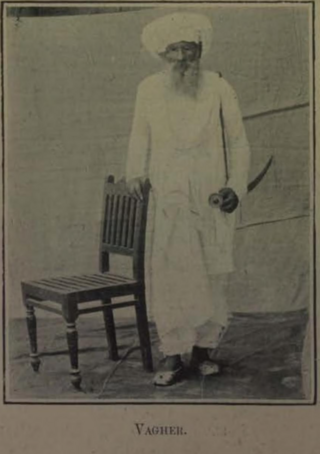Related Research Articles

Kutch district, officially spelled Kachchh, is a district of Gujarat state in western India, with its headquarters (capital) at Bhuj. Covering an area of 45,674 km2, it is the largest district of India. The area of Kutch is larger than the entire area of other Indian states like Haryana (44,212 km2) and Kerala (38,863 km2). The population of Kutch is about 2,092,371. It has 10 talukas, 939 villages and 6 municipalities. The Kutch district is home to the Kutchi people who speak the Kutchi language.

The Gulf of Kutch is located between the peninsula regions of Kutch and Saurashtra, bounded in the state of Gujarat that borders Pakistan. It opens towards the Arabian Sea facing the Gulf of Oman.
Events in the year 1877 in India.

The Rabari people are an ethnic group from Rajasthan, Kutch region of Gujarat, Haryana, Punjab and Sindh province of Pakistan.

Jadeja is a Rajput clan that inhabits the Indian state of Gujarat and the Tharparkar district of Sindh, Pakistan. They originated from Sammas of Sindh, a pastoral group, and laid a claim on the Rajput identity after marriages with Sodha Rajput women by adopting a process called Rajputisation.
Rajesh Chauhan is a former Indian cricketer who played in 21 Tests and 35 One Day Internationals from 1993 to 1998. He was part of the Indian spin trio of Kumble-Raju-Chauhan, in the 1990s.

Madhapar is a village located in Kachchh district in the state of Gujarat, India. It is one of the richest villages in India in terms of bank deposits. The village has around 7600 households and 2000 crore Indian rupee worth bank deposits.
The Bhadala are an ethnic group found in Pakistan and India. They are found mainly in the Kutch District of Gujarat. In Pakistan, they are found mainly in Karachi. The Bhadala are an ethnic group found in Pakistan and India. They are found mainly in the Kutch District of Gujarat. In Pakistan, they are found mainly in Karachi.
Nagor or Nagher is a village in Bhuj Taluka of Kutch at a distance of about 8 km from Bhuj town, the capital of Kachchh District of Gujarat in India.

Hajapar is a village in Bhuj Taluka of Kachchh District of Gujarat State of India. It is located at a distance of about 18 km from Bhuj. One nearby village is Reha. As per some old records & books of Kutch Gurjar Kashtriya community Hajapar was also known as Rajapar in olden days. Rajapar is to be named after RAJAJI VARU. RAJAJI VARU was a bravest warrior and his Paliya at Jodiya town behind government high school and gita mandir. Many Paliyas are also there. The Paliyas in the memory of battle was fought for cattle herd under the leadership of RAJAJI VARU against cattle herd theft group at battlefield. RAJAJI VARU is a Surapura Dada of VARU family.

Dhaneti or Dhanetee is a village in Bhuj Taluka of Kutch District of Gujarat State of India. It is at a distance of about 26 km from Bhuj the Taluka and district headquarters of Kutch. Although it is in Bhuj Taluka, the Anjar Taluka headquarters of Anjar is only 18 km away.
Kutch Gurjar Kshatriya are a minority Hindu community of Gujarat in India, who claim to be Kshatriyas. They are an artisan community related with masonry, artistic carvings, sculpting and building and construction works. They are also known as the Mistri or Mistris of Kutch.
The Mistri are a Hindu caste found in state of Gujarat, India.

The Rann of Kutch is a large area of salt marshes that span the border between India and Pakistan. It is located mostly in the Kutch district of the Indian state of Gujarat, with a minor portion extending into the Sindh province of Pakistan. It is divided into the Great Rann and Little Rann.
The Hingora is a Sindhi Muslim tribe found in the Sindh province of Pakistan and in Indian states of Gujarat and Rajasthan. They are one of a number of communities of Maldhari pastoral nomads found in the Banni region of Kutch.
The Mutwa are a Muslim community found in the state of Gujarat in India and a province of Sindh in Pakistan. They are one of a number of communities of Maldhari pastoral nomads found in the Banni region of Kutch.
The Manka are a partly Muslim and partly Hindu community found in the state of Gujarat in India.
The Node community, also known as Nodi or Nodhi, is a Muslim community primarily found in the state of Gujarat in India and the province of Sindh in Pakistan. They are one of several pastoral nomadic communities inhabiting the Banni region of Kutch.

Wagher, Vagher or Waghir is a jāti from the Saurashtra and Kutch regions of Gujarat in India. Some Waghers are Hindu and others are Muslim. They speak Kutchi as a mother tongue.
Weaving and cloth trading communities of Western India particularly of Gujarat are called Vankar/Wankar/Vaniya. The four major woven fabrics produced by these communities are cotton, silk, khadi and linen. Today majority of these community members are not engaged in their ancestral weaving occupation still some population of these community contribute themselves in traditional handloom weaving of famous Patola of Patan, Kachchh shawl of Bhujodi in Kutch, Gharchola and Crotchet of Jamnagar, Zari of Surat, Mashroo of Patan and Mandvi in Kutch, Bandhani of Jamnagar, Anjar and Bhuj, Motif, Leheria, Dhamakda and Ajrak, Nagri sari, Tangaliya Shawl, Dhurrie, Kediyu, Heer Bharat, Abhala, Phento and art of Gudri. Vankar is described as a caste as well as a community.
References
- ↑ Vidyarthi, Lalita Prasad; Rai, Binay Kumar (1977). The Tribal Culture of India. Concept Publishing Company.
- ↑ Khare, Randhir (2004). Kutch, Triumph of the Spirit. Rupa & Company. ISBN 978-81-291-0306-2.